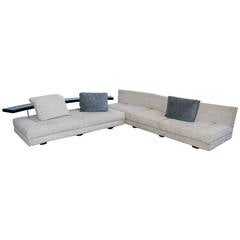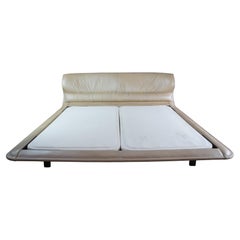Avedon Sofa
Recent Sales
Late 20th Century Italian Modern Sectional Sofas
Steel
Vintage 1970s Mid-Century Modern Beds and Bed Frames
Leather
Avedon Sofa For Sale on 1stDibs
How Much is a Avedon Sofa?
Gufram Furniture for sale on 1stDibs
The brainchild of the Fratelli Gugliermetto company, Gufram was born in 1966 in Turin, Italy, massively inspired by the avant-garde artistic culture that reigned in Europe during the 1960s and '70s. The brand is known for its CACTUS coat stand and sculptural seating such as the Pratone chair as well as other massive, innovative pieces that fall somewhere between art and furniture.
Starting in the mid-1960s, proponents of Italian Radical Design — which included forward-looking collectives like Archizoom and Studio 65 — broke with formality and convention by fusing the joy of Pop art with the systems of mass production.
One of the brands that formed as a result of these experiments was Gufram, a manufacturer at the forefront of the country’s Radical Design movement. The Gugliermetto brothers teamed up with emerging artists to harness exciting new materials — among them, polyurethane foam, which was originally used in the transportation industry as insulation to keep buses and trains warm.
Despite being credited for revolutionizing Italian design, until the mid-1970s, Gufram was largely unknown outside the small Italian town where it was founded. Nearly six years after the brand’s inception, though, word got out about a furniture brand transforming polyurethane foam into gigantic works of art. So, Gufram brought its playful and witty design concept across the Atlantic to New York’s Museum of Modern Art, where it had its first international show.
Gufram produced much of the Pop furniture — the CACTUS coat rack by Guido Drocco and Franco Mello and the Bocca sofa, in the shape of big red lips, by Studio 65 — that came to define the Anti-Design movement. (Through a relationship with Gufram, the latter was imported to the United States by Charles Stendig, a collector and pioneering importer who helped spark America’s interest in furniture from Finland, Switzerland and Italy during the 1960s and ‘70s.)
Although furniture can be serious business, it’s just as often playful, provocative, energizing and even liberating. Perhaps nothing embodies these characteristics better than postmodern Italian design. And one of the most iconic pieces to originate during Italy’s fertile period of postmodern furniture design is the Pratone chair, designed in 1971 by Giorgio Ceretti, Piero Derossi and Riccardo Rosso.
Representing a magnified portion of a grassy meadow, the Pratone chaise provides a lounging place for an individual or a group. “It is so unlike anything else that it stands out and is still iconic after 50 years,” said Charley Vezza, Gufram’s global creative orchestrator.
Made of painted polyurethane foam, the Pratone chair immediately became the symbol of a new and different approach to interiors when it debuted.
Gufram has become a favorite of the international art crowd and glitterati, and its products have made their way to the world’s most renowned museums, including the Metropolitan Museum of Art, Vitra Design Museum and more.
British fashion designer Paul Smith and American multi-hyphenate artist A$AP Rocky have collaborated with Gufram over the years. Interior designer Tony Ingrao has called the Pratone chair one of his favorite works and featured the larger-than-life piece in an exhibition he curated at R & Company in 2016.
Find new and vintage Gufram chairs, sofas, mirrors and other Gufram furniture for sale on 1stDibs.
A Close Look at Modern Furniture
The late 19th and early 20th centuries saw sweeping social change and major scientific advances — both of which contributed to a new aesthetic: modernism. Rejecting the rigidity of Victorian artistic conventions, modernists sought a new means of expression. References to the natural world and ornate classical embellishments gave way to the sleek simplicity of the Machine Age. Architect Philip Johnson characterized the hallmarks of modernism as “machine-like simplicity, smoothness or surface [and] avoidance of ornament.”
Early practitioners of modernist design include the De Stijl (“The Style”) group, founded in the Netherlands in 1917, and the Bauhaus School, founded two years later in Germany.
Followers of both groups produced sleek, spare designs — many of which became icons of daily life in the 20th century. The modernists rejected both natural and historical references and relied primarily on industrial materials such as metal, glass, plywood, and, later, plastics. While Bauhaus principals Marcel Breuer and Ludwig Mies van der Rohe created furniture from mass-produced, chrome-plated steel, American visionaries like Charles and Ray Eames worked in materials as novel as molded plywood and fiberglass. Today, Breuer’s Wassily chair, Mies van der Rohe’s Barcelona chair — crafted with his romantic partner, designer Lilly Reich — and the Eames lounge chair are emblems of progressive design and vintage originals are prized cornerstones of collections.
It’s difficult to overstate the influence that modernism continues to wield over designers and architects — and equally difficult to overstate how revolutionary it was when it first appeared a century ago. But because modernist furniture designs are so simple, they can blend in seamlessly with just about any type of décor. Don’t overlook them.
Finding the Right Sofas for You
Black leather, silk velvet cushions, breathable bouclé fabric — when shopping for antique or vintage sofas, today’s couch connoisseurs have much to choose from in terms of style and shape. But it wasn’t always thus.
The sofa is typically defined as a long upholstered seat that features a back and arms and is intended for two or more people. While the term “couch” comes from the Old French couche, meaning to lie down, and sofa has Eastern origins, both are forms of divan, a Turkish word that means an elongated cushioned seat. Bench-like seating in Ancient Greece, which was padded with soft blankets, was called klinai. No matter how you spell it, sofa just means comfort, at least it does today.
In the early days of sofa design, upholstery consisted of horsehair or dried moss. Sofas that originated in countries such as France during the 17th century were more integral to decor than they were to comfort. Like most Baroque furnishings from the region, they frequently comprised heavy, gilded mahogany frames and were upholstered in floral Beauvais tapestry. Today, options abound when it comes to style and material, with authentic leather offerings and classy steel settees. Plush, velvet chesterfields represent the platonic ideal of coziness.
Vladimir Kagan’s iconic sofa designs, such as the Crescent and the Serpentine — which, like the sectional sofas of the 1960s created by furniture makers such as Harvey Probber, are quite popular among mid-century modern furniture enthusiasts — showcase the spectrum of style available to modern consumers. Those looking to make a statement can turn to Studio 65’s lip-shaped Bocca sofa, which was inspired by the work of Salvador Dalí. Elsewhere, the furniture of the 1970s evokes an era when experimentation ruled, or at least provided a reason to break the rules. Just about every area of society felt a sudden urge to be wayward, to push boundaries — and buttons. Vintage leather sofas of that decade are characterized by a rare blending of the showy and organic.
With so many options, it’s important to explore and find the perfect furniture for your space. Paying attention to the lines of the cushions as well as the flow from the backrest into the arms is crucial to identifying a cohesive new piece for your home or office.
Fortunately, with styles from every era — and even round sofas — there’s a luxurious piece for every space. Deck out your living room with an Art Deco lounge or go retro with a nostalgic '80s design. No matter your sitting vision, the right piece is waiting for you in the expansive collection of unique sofas on 1stDibs.

